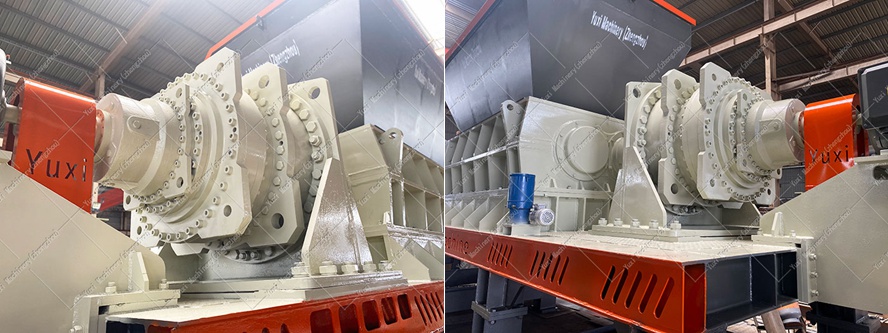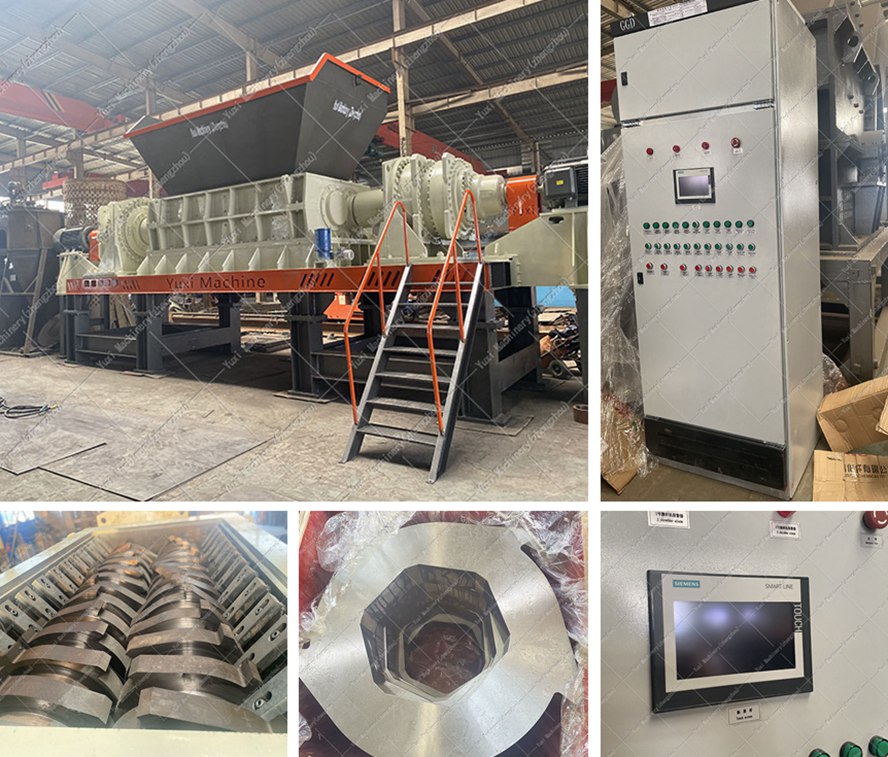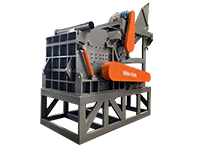In the daily operation of chemical, auto repair and manufacturing industries, the accumulation of waste paint buckets, coating buckets and chemical iron buckets will take up a lot of space—1,000 buckets occupy about 50 cubic meters, and only 200 buckets can be loaded per truck during transportation, with a cost of up to 12 yuan per bucket; if randomly stacked, it may also lead to a fine of 20,000 to 50,000 yuan from environmental protection departments due to residual paint leakage.
Through the composite crushing technology of "extrusion-shearing-hammering", the paint bucket shredder can reduce the volume of the bucket by more than 80%, and the transportation cost is reduced to 3.5 yuan per bucket. It is the core equipment for closed-loop treatment of industrial solid waste.

1. Working Principle of Paint Bucket Shredder (You May Wonder)
The crushing process of a paint bucket shredder is divided into 3 efficient links:
1. Feeding and Fixing: The automatic pressing device clamps the bucket body to avoid bouncing during crushing. This design can improve the feeding efficiency by 30% and reduce potential safety hazards.
2. Composite Crushing Process: The high-speed rotating (about 1,200 rpm) cutter head first extrudes and deforms the bucket body, then shears and separates it into strips, and finally hammers it into uniform fragments of 5-20 cm. The processing time per bucket is only 2-3 seconds.
3. Discharging and Screening: The crushed fragments are screened through a sieve. Those that meet the size requirements are discharged directly, and those that do not meet the requirements will be crushed again to ensure all fragments meet the requirements of recycling or transportation.
2. Application Scenarios of 3 Types of Paint Bucket Shredders
You can choose the corresponding equipment type according to the processing scale and needs:
• Small Vertical Shredder: Power 15-30kW, processing capacity 1-5 tons per hour, floor area about 3×2 meters, equipped with manual feeding and basic dust removal system, suitable for decentralized scenarios such as auto repair shops and small factories.
• Medium Horizontal Shredder: Power 37-75kW, processing capacity 5-20 tons per hour, floor area about 5×3 meters, equipped with automatic conveyor belt and pulse dust removal system, suitable for centralized processing scenarios such as medium-sized recycling enterprises and industrial parks.
• Large Production Line: Power 110-160kW, processing capacity 20-50 tons per hour, floor area about 10×5 meters, can be equipped with cleaning, sorting, briquetting and other equipment, suitable for large-scale processing scenarios such as large solid waste treatment centers.
3. Core Value of Paint Bucket Shredder (Why You Need It)
The paint bucket shredder can not only solve the problem of solid waste accumulation, but also bring 3 core values:
• Cost Reduction and Efficiency Improvement: Reduce volume by more than 80%, reduce transportation cost by 70%, and reduce the processing cost per bucket from 12 yuan to 3.5 yuan.
• Environmental Compliance: Separate residual substances, avoid leakage pollution, help enterprises pass environmental protection acceptance and stay away from the risk of fines.
• Resource Value-Added: The crushed metal fragments have low impurity content, and the recycling price is 33% higher than that of the whole bucket, realizing "turning waste into treasure".

4. 7 Core Selection Indicators of Paint Bucket Shredder (Must See)
To select equipment that meets the needs and has high cost performance, you need to focus on the following 7 indicators:
1. Matching Processing Capacity: Select the processing capacity according to "daily number of paint buckets produced × 1.2". For example, if 500 buckets (about 0.5 tons) are produced per day, choose a 1-ton-per-hour equipment to avoid long-term overload operation of the equipment.
2. Adjustability of Crushing Granularity: Priority is given to equipment that supports 3-20 cm granularity adjustment—adjust to 3-5 cm (impurity content < 5%) for recycling, and adjust to 10-20 cm (improve processing efficiency) for volume reduction and transportation only.
3. Explosion-Proof Safety Configuration: If processing buckets with flammable and explosive residues such as paint and solvents, choose explosion-proof motors + inert gas protection systems to avoid sparks during crushing.
4. Anti-Corrosion Cutter Material: When processing buckets with acidic/alkaline residues, choose stainless steel 304/316 material cutters—ordinary carbon steel cutters will be corroded and scrapped in 3 months, while stainless steel cutters have a service life of more than 12 months.
5. Energy Consumption and Frequency Conversion System: Small equipment consumes 15-30 kWh per hour, medium equipment consumes 37-75 kWh per hour. Equipment equipped with frequency conversion system can adjust power according to load, saving 15-20% of electricity.
6. Dust Collection Efficiency: Choose pulse bag dust collectors with a filtration accuracy of 0.3 microns to ensure that the dust emission concentration is < 10mg/m³, which meets the "Comprehensive Emission Standard of Atmospheric Pollutants".
7. Replacement Cost of consumable parts (Wear Parts): Understand the unit price and replacement cycle of cutters, sieves and gaskets in advance—cutters need to be replaced after processing 500-1000 tons of materials, and the cost of a single set of cutters is recommended to be controlled within 5% of the total equipment price.
5. 4-Step Daily Maintenance of Paint Bucket Shredder (Extend Service Life by 30%)
Proper maintenance can greatly reduce the probability of equipment failure. The specific steps are as follows:
1. Daily Shutdown Inspection (5 minutes): Clean the dust on the filter bag of the dust collector, check whether there is residue at the feed inlet and discharge outlet, and test whether the emergency stop button works normally.
2. Weekly Lubrication and Maintenance (10 minutes): Add 5-10 grams of lithium-based grease to the bearing parts, and check the tightness of the conveyor belt (it is appropriate to press 1-2 cm).
3. Monthly In-Depth Inspection (30 minutes): Check the lubricating oil level of the gearbox, test the overload protection function, and check whether the gasket leaks.
4. Quarterly Replacement and Calibration (60 minutes): Replace the gear oil in the gearbox, check the wear of the cutter (replace if the wear exceeds 1/3), and calibrate the sieve aperture.
Frequently Asked Questions (FAQ)
1. Can the paint bucket shredder handle buckets with residual paint?
Yes. Professional equipment is equipped with a leak-proof sealing system, which can handle buckets with residual amount ≤ 10%. Some models also support residual liquid recovery in the pre-processing link.
2. Will the operating noise of the paint bucket shredder affect the surrounding area?
The operating noise of conventional equipment is 85-95 decibels. Models equipped with sound insulation covers + shock-absorbing pads can be reduced to below 75 decibels, which meets the "Environmental Noise Emission Standard for Industrial Enterprises".
3. How much higher is the recycling price of crushed metal fragments than that of the whole bucket?
The recycling price of the whole paint bucket in steel mills is about 1,800 yuan/ton, and the recycling price of fragments with impurity content < 5% after crushing is about 2,400 yuan/ton, an increase of 33% in unit price, and the transportation cost is reduced by 70% at the same time.
4. What conditions are required for the installation of the paint bucket shredder?
• Small equipment requires 380V industrial power supply, medium and above equipment requires 100A or above air switch;
• The ground needs to be flat and hardened, with a load-bearing capacity ≥ 500kg/㎡;
• 1-2 meters of operating space should be reserved for easy maintenance and feeding.

 Shredding Machine
Shredding Machine
 Waste Recycling Line
Waste Recycling Line
 Optional Equipment
Optional Equipment



